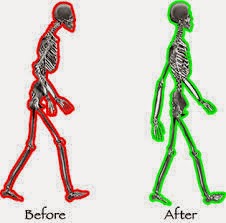Core Strength
Why do we all work so hard on 'core strength'. Core strength and Abdominal Strength, two very different things...I intend to get to the bottom of this.
Abdominal workouts, do exactly as prescribed - they work your abdominal muscles. These are not to be confused with core strength. Core strength does way more for your body.
Core work incorporates literally dozens of muscles, and improves strength and flexibility in your hips, pelvis, lower back, and abdominals. There are many reasons why a developed core is better than just developed abdominals. Such as:
Agility
Core muscles allow you to react faster, with greater strength. Core strength also lets your body distribute stress evenly, absorbs shock more effectively and contribute to your balance, coordination, flexibility and self awareness.Power
Believe it or not, performing Squats and Dead Lifts with proper technique will develop your core, increasing your power but most importantly it will stabilise and protect your lower back. This type of conditioning develops your muscles, via your core, to allow your body to develop a good foundation for heavier weights and prevents injuries.Posture
A good core workout will centre your spine and this will enable you to stand and sit with better, more erect posture. I've noticed huge development for my own posture in the past 90-odd days. The main thing here, is if you want a 6 pack or good looking abs, then posture development strengthen the lower back. You even appear taller / slimmer!
Weight Loss
Strong core equals less fatigue and reduced effort in performing daily activity. This reduced effort and fatigue directly translates to more available energy to put into gym time, running, cycling etc. You'll also be at a reduced risk of injury when you're carrying less weight, and reduced risk of exhaustion because you have the additional energy to sustain you!
Way More than a 6 Pack
I've realised from the women in my life, that strong cores as a foundation mean gym work is made far easier. I didn't realise that such a large portion of the male population don't even consider core training, and solely focus on muscle development. This often means the obliques, lower back, hips get less of a workout (if at all) and often just get pounded with heavy weights! It is the recommendation of most fitness professionals to develop core strength FIRST, to gain strength and stability to allow you to do the muscle building activity later.
But Why?
When is Core Strength useful to me, and why haven't I been doing it...Well, I actually have been. I was bashing away in the gym, decided at about 10 weeks (if I recall correctly), that my workouts would include more endurance (abs between weights), and that my weights workout since week 8 (I think) have been predominantly compound instead of isolated. Endurance training and working in the abdominals intensified and added some spice to my weights regime. Compound training added the base core work, required me to drop to smaller weights and develop better technique. I stuck with it, and now I feel particularly strong, in comparison to this time a year ago. I feel fitter today, than ever before. Good reason to kick start your routine into adding more core and compound training? I think so!
Core strength is integral in my marathon and triathlon goals. It is pivotal in my overall development since I need to maintain a strong core so I can pound my body over 42km. I need to load my muscles with memories of endurance, strength training and the kilometres in my legs. All of this contributes, and as my core has developed (slowly), I've noticed that my running technique has improved. I was omnipresent this evening as I straightened my posture, well noticed that it was more erect as I put a swift 5km on the treadmill.
WOD
My Workout Of the Day, as created by me, was to replicate this core strengthening, and keep my legs from taking a break.
I started with 30 minutes of abdominal weights training, focusing on core alignment, and not just the abdominal workout. I then proceeded to do a 30 minute core crushing kettle bell circuit. I transitioned between medium and heavy bells, and worked different parts of my core. I also included a swift 5km treadmill run, which had me running at around 5min/km, for 25 minutes. My heart rate peaked at 143bpm and I focused on twisting my core muscles and keeping a straight posture as I ran. It felt good!
My WOD - Part 1 Abdominals: (3x15reps)
- Standing Weighted Cable Pulldown Crunch
- Kneeling Weighted Cable Pulldown Crunch
- Palof Press
- Landmine 180's
- Plate Twists
- Plate Side Bends
- Kettle Bell Figure 8 Crunches
- Goblet Squat
- Around Body
- Bent Over Row
- Figure 8 (in bent over position)
- Single Leg Dead Lifts
- Windmills
- Shoulder Press
- Half Get Ups
- Step Ups
- Squat Swings
Stretches, Side Plank Pulses, V-Sits, Figure 4 Abs & Thigh Crunches to finish me off.











































